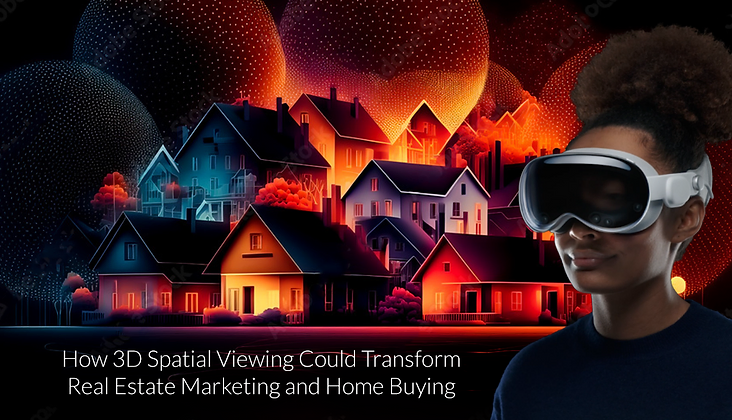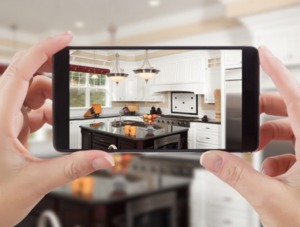How 3D Spatial Viewing Could Transform Real Estate Marketing and Home Buying
The ability to capture and experience immersive 3D spatial photos and videos is set to completely revolutionize real estate browsing and transactions in the coming years. With new spatial viewing technologies on the horizon from companies like Apple, the real estate industry is on the cusp of a significant visual overhaul.
In this in-depth article, we’ll look at how 3D spatial viewing works, the key devices bringing it mainstream, and how features coming to products like the Vision Pro headset and rumored iPhone 16 Ultra will soon impact real estate marketing and home buyers.
Understanding 3D Spatial Viewing Technology:
3D spatial viewing, much like today’s real estate virtual tours, utilizes advanced camera systems and display methods to immerse users in digital environments as if inside them. Rather than looking at a flat 2D image or standard video, spatial technology creates a lifelike interactive experience.
The technology works by first capturing a given location in full 360-degree 3D. Typically, an array of outward-facing cameras and depth/LiDAR sensors scan all aspects of a real-world environment.
This captures not only the visual details but also the depths and dimensions needed to recreate the space digitally in three full dimensions. The 3D model creates a virtual replicate of the actual location.
To view the 3D space, specialized headsets like the upcoming Apple Vision Pro use displays that project an image independently to each eye. This stereoscopic effect tricks the brain into seeing depth since each eye views the environment from a slightly different angle.
The headset tracks head movements and updates the display accordingly, letting users look around the virtual space seamlessly in all directions by simply turning their heads. This creates a true immersion in a digital world.
Rumored 3D Photo and Video Capabilities in iPhone 16 Ultra:
According to leaks from reliable sources, the premium iPhone 16 Ultra planned for release in 2024 will likely include camera and sensor hardware enabling 3D spatial photo and video capture.
The iPhone already possesses depth-sensing capabilities thanks to LiDAR integration in recent Pro models. This provides raw data to generate 3D spaces. The iPhone 16 Ultra is expected to take this a step further with enough cameras and scanning to replicate environments spatially.
Capturing 3D photos and videos directly from the iPhone 16 Ultra will make creating immersive spatial content easy for average consumers. This will help fuel the adoption and usage of 3D across many new applications.
Apple Vision Pro Headset Paving the Way for Spatial Viewing:
While the iPhone 16 Ultra will put 3D capture tech into millions of consumers’ hands, Apple’s upcoming Vision Pro headset will first showcase the transformative powers of spatial viewing.
Slated for release in early 2024, the Vision Pro features displays that can project photo-realistic 3D environments. It allows users to explore digital worlds by simply looking around, making it feel like being there physically.
The Vision Pro experience highlights the massive potential of immersive 3D spatial viewing. It shows how the technology could enhance everything from communications to entertainment, design, training, and more.
But most relevantly, Vision Pro sets the stage for 3D to revolutionize the real estate space next.
Benefits of 3D Spatial Viewing for Real Estate Marketing:
For those listing or selling properties, 3D spatial viewing unlocks game-changing new ways to market real estate digitally. Instead of imagining a space based on 2D photos, agents can create an interactive visual experience for prospective buyers.
Immersive 3D brings real estate marketing to life by enabling:
- Fully navigable 3D open house tours of listed properties
- Life-size VR renderings with realistic depth and scale
- Dimensionally accurate spatial floor plans
- Detailed aerial 3D mapping of land, yards, etc.
Rather than guessing at room proportions, finishes, staging, etc., based on flat images, buyers can feel transported directly into a digital representation of the space thanks to 3D.
This allows real estate companies to showcase listings in unprecedented detail. Spatial viewing lets shoppers intuitively evaluate factors like flow, layout, views, lighting, and furnishings.
Next-Generation Home Shopping Experience for Buyers:
On the consumer side, the coming wave of spatial viewing technology promises to enhance the home shopping process dramatically.
By previewing immersive 3D environments virtually, home buyers can comprehensively assess if a property fits their needs and preferences before visiting in person. Spatial tech enables evaluating:
- Room sizes, space planning, storage
- Natural light and exterior views
- Yard proportions and landscaping
- Appliances, fixtures, layout ergonomics
- Overall design cohesion and decor
This helps prevent disappointments from incomplete 2D listings and gives confidence in making offers. For many buyers, spatial viewing can replace exhaustive in-person tours, saving huge amounts of time.
Those relocating can also vet locations thoroughly in 3D without costly travel. Spatial viewing solves many friction points and uncertainties of current real estate browsing.
The Imminent Spatial Era in Real Estate:
As transformational devices like Apple’s Vision Pro headset and rumored iPhone 16 Ultra with 3D capture arrive in the coming years, they stand to kick off the next era of disruption in real estate. Listing, buying, and selling properties will likely involve interactive spatial viewing as a core need.
Within five to ten years, VR and AR-driven 3D experiences will likely replace 2D photos as the new normal and expectation in real estate marketing. Much like streaming TV and smartphones fundamentally changed their industries practically overnight, the versatility and realism of spatial viewing are set to redefine real estate transactions completely.
Conclusion:
Driven by upcoming advances in devices from Apple and others, 3D spatial viewing via AR and VR headsets and phones will unleash profound changes to real estate browsing and buying. From personalized virtual tours to enhanced marketing abilities, immersive 3D spatial environments are about to transform the real estate space. For agents and consumers, the scope of what’s possible with interactive digital real estate experiences is immensely expansive. As spatial viewing technologies become cheaper and more common, they will rapidly rise from novelty to essential in the near future of real estate selling and buying.





